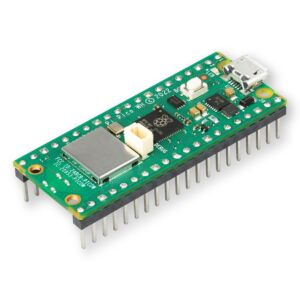Related Content
Transcript
Access the full workshop here: https://core-electronics.com.au/courses/raspberry-pi-pico-workshop/
There are quite a few Pico variants that you will encounter, and at first, it may seem a little bit confusing, but they all follow a nice and straightforward naming scheme. So first of all there is the Pico and the Pico 2, and it's exactly what it seems like. The Pico is the original model, and the Pico 2 is the second-generation model. It's newer, faster, about 2-3 times faster, and it comes with a few hardware improvements here and there. The majority of this course is able to be completed with both the original Pico and Pico 2. And although the Pico 2 is faster, we rarely run anything that's too demanding or processing-intensive. So for the things we do in this course, you won't really notice a difference between the two. They're pretty much interchangeable, but if you want to get something more powerful for future projects, get a Pico 2. If you want to save a few bucks, get the original Pico.
So these are the base models of the Pico, but there are some additional things that they can come with. One of these things is this big silver wireless chip here, which gives it Wi-Fi and Bluetooth capabilities, something that the base model Pico doesn't have. And these versions will have a W in their name. So the Pico 2 W and the Pico W are just the base models, but with this additional wireless chip, and apart from that fancy chip, they're functionally the same as the regular ones. We will be doing some cool stuff with Wi-Fi in a later chapter, so we do recommend you get one with the wireless chip.
Now your Pico does need these pin headers soldered to it. These are what we'll be using to connect things to it with. If you get one of these base models, you will need to buy some pins and manually solder them on yourself. Or you can save some trouble and buy one that comes with them already soldered on. If it has a H in its name, it will come with these pins. So for example, the Pico, no pin headers, and you'll need to solder them on, the Pico H already comes with them, no soldering required. And this also applies to the wireless ones. The Pico W, no headers and you'll need to solder them on. The Pico WH comes with the headers and wireless. So you can choose the Pico generation, the original Pico, to save some cash, or the more powerful Pico too. If it has a W in its name, that means that it's a version that comes with the wireless chip. And if it has a H in its name, it will come with the headers already soldered on so you won't need to do so. And at the end of the day, if you don't know which one to get, just get one of the WH models. That way you can do the wireless stuff we do in the wireless chapter and you don't need to solder anything.
Comments

Makers love reviews as much as you do, please follow this link to review the products you have purchased.











